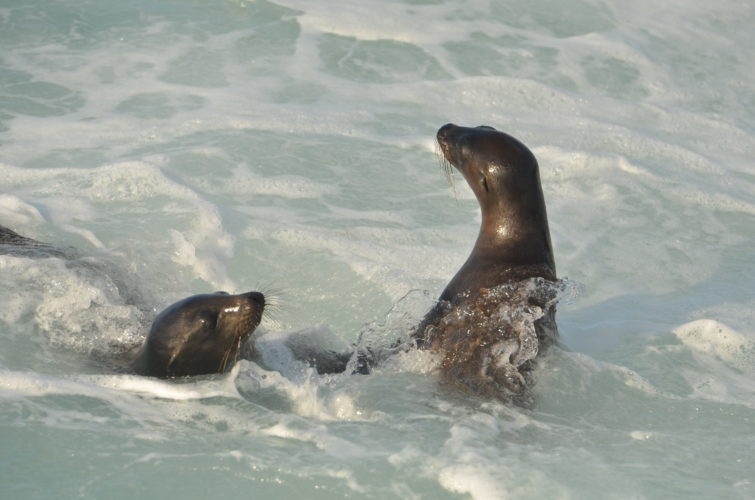July 14, 2025
Galápagos Cool Season Secrets: What to Expect from June to November

If you’re planning a trip to the Galápagos Islands between June and November, you’ll be visiting during a season of transformation, both on land and under the sea. Known locally as the “garúa” season, this time of year is shaped by the arrival of the Humboldt Current, which brings cooler, nutrient-rich waters to the region.
As ocean currents shift, marine conditions become ideal for wildlife activity, especially below the surface. While the Galápagos is an extraordinary destination year-round, this time of year brings its own unique character, with fewer visitors, comfortable temperatures, and increased opportunities for memorable marine wildlife encounters.
Let’s take a closer look at what the Galápagos is like during this time, and why many travelers consider it the best-kept secret of Galápagos travel.
🌊 Ocean Changes: What to Expect?
Cooler, Nutrient-Rich Waters
While multiple ocean currents shape the Galápagos ecosystem year-round, two major systems become especially influential from June onward:
- The Humboldt Current: A cold, nutrient-rich current that flows northwest from the coast of South America. It begins strengthening in June, peaks in August and September, and significantly lowers sea temperatures throughout the archipelago.
- The Cromwell Current: A deep, eastward-flowing current that rises to the surface around the western islands (like Isabela and Fernandina), delivering a steady upwelling of nutrients from the ocean floor.
Together, these currents cool the waters and fuel a burst of marine productivity. The result? A food-rich environment that attracts a wide range of marine life.
You’ll notice:
- Chillier water temperatures, typically between 18–23°C (64–73°F) depending on the island and month.
- Plankton blooms, which can reduce visibility slightly, but also bring the ocean to life.
- Increased marine activity, from hunting sea lions to bait-ball feeding frenzies involving seabirds, fish, and larger predators like sharks.
☁️ Climate and Conditions
As the ocean cools, land temperatures also drop, making this season especially comfortable for hiking, biking, and other land-based adventures. If you’re sensitive to heat, this is one of the best times to visit, the air is cooler, and the humidity is lower than during the hot rainy season.
Expect:
- Air temperatures averaging 19–26°C (66–79°F) depending on location and elevation.
- Lower humidity, offering a more pleasant experience, especially in the lowlands.
- Overcast mornings, especially in the highlands, due to the seasonal garúa mist, a light fog that keeps the vegetation green and the landscapes dramatic.
- Choppier seas, especially from July to October. Interisland boat rides can be rougher during this season, so if you’re prone to seasickness, it’s wise to bring motion sickness remedies and plan accordingly for a more comfortable journey.
🐢 Wildlife Activity Highlights: June to November
The cool season is a lively and dynamic time for wildlife across the Galápagos. From migrations and breeding to playful young animals, here are just a few reasons nature lovers are drawn to Galapagos during these months:
- Blue-footed boobies perform their iconic courtship dance, with peak activity from June to August—a favorite among photographers and birdwatchers.
- Whales and dolphins may appear during inter-island crossings. While sightings are never guaranteed, migratory species are more commonly seen during these cooler months.
- Giant tortoises begin their migration inland to nesting areas (June–August).
- Waved albatrosses on Española are nesting and raising chicks, a unique sight only available between April and December.
- Galápagos penguins are more active in the cool waters, especially around Bartolomé and Isabela, making them easier to spot during snorkeling excursions.
- Sea lions are pupping (August–November), meaning curious pups are often seen playing in tidepools.
- Marine iguanas gather in larger groups and become more active feeders, diving into the cool waters to graze on algae.

🎒 Travel Tips for the Cool Season
Traveling from June to November? A few smart packing choices will help you stay comfortable during all your land and sea adventures:
- Pack light layers: Mornings and evenings can feel crisp, especially with the ocean breeze. Since many of our dinners are enjoyed outdoors, it’s great to have a sweater or light jacket for cooler nights.
- Bring a lightweight waterproof or windbreaker jacket: This is especially useful for highland hikes, where mist and light rain are more common.
- Don’t forget reef-safe sunscreen: Even on overcast days, UV rays are strong in the Galápagos.
👉 Here’s a helpful guide with essential and fun items you might want to bring for marine activities: Must-Pack List for an Amazing Galápagos Marine Adventure
🗓️ Why Travel During June to November?
The Galápagos offers incredible experiences year-round, with each season bringing its own natural rhythms and highlights. From June to November, the islands shift into a cooler, nutrient-rich season that transforms both land and sea in subtle but fascinating ways.
Here’s what makes this time of year uniquely rewarding:
- Mild adventure weather: Cooler air and lower humidity make hiking, biking, and exploring more comfortable, especially for those sensitive to heat.
- A different pace: While visitor numbers are carefully managed all year, this season tends to feel quieter and more reflective, a great fit for those looking to explore at a more relaxed pace.
- Season of Life: Many species take advantage of the cooler, nutrient-rich conditions to nest, breed, and feed. For visitors, this means more chances to witness unique wildlife moments—you might spot chicks in nests, sea lion pups playing along the shore
Experience It with Galakiwi
As a locally based tour operator, we’ve guided countless guests through the cool season and know how to make the most of every day, whether you’re exploring volcanic landscapes, swimming with penguins, or watching sea lions raise their pups.
Join us for a land-based Galápagos adventure that connects you to wildlife, culture, and community in the most authentic way possible.
